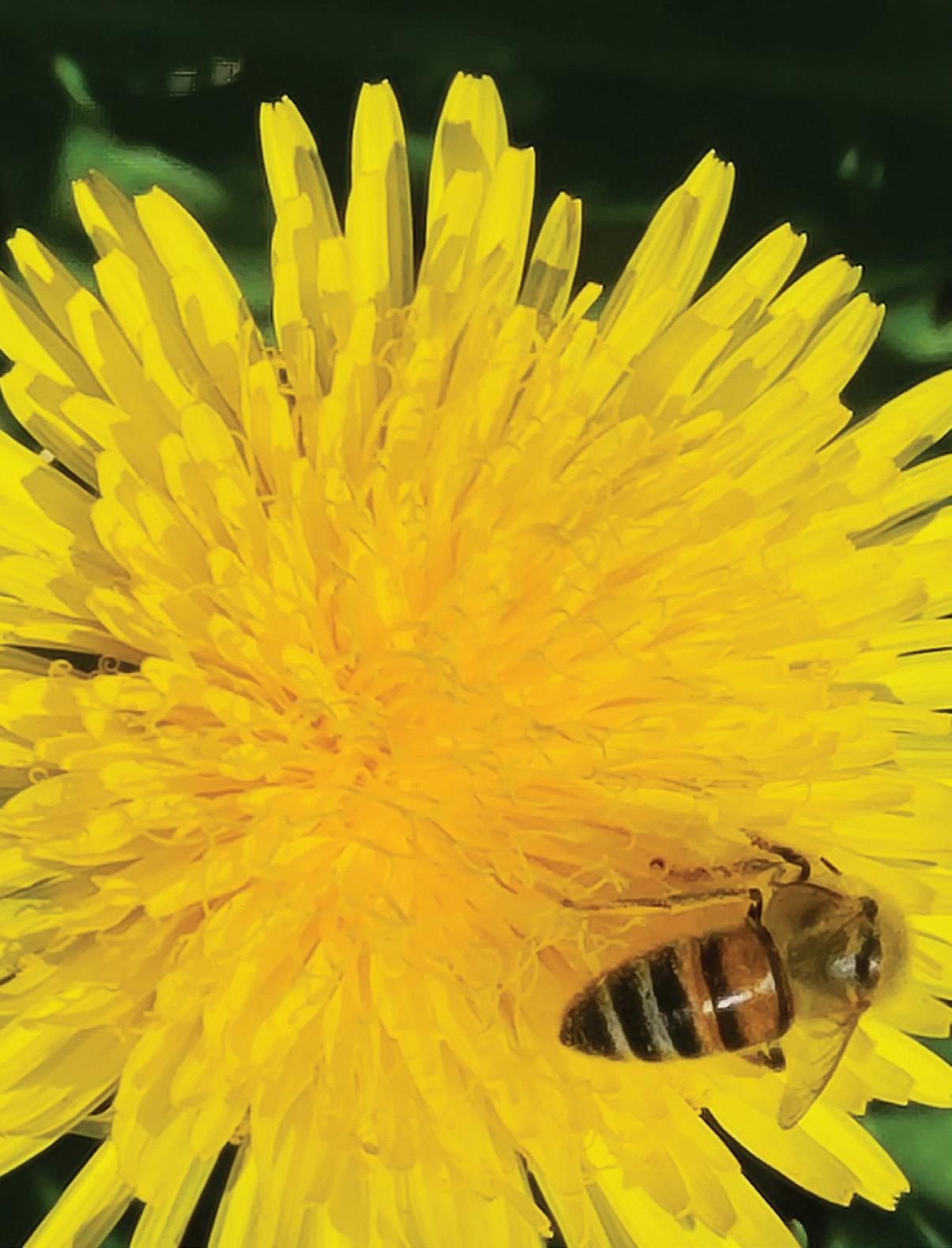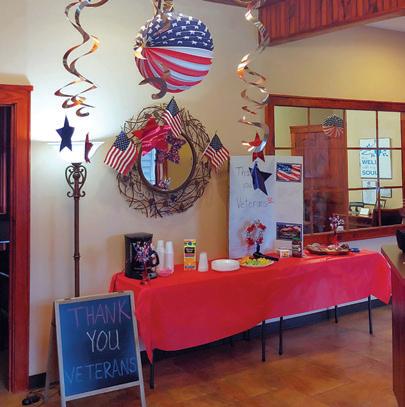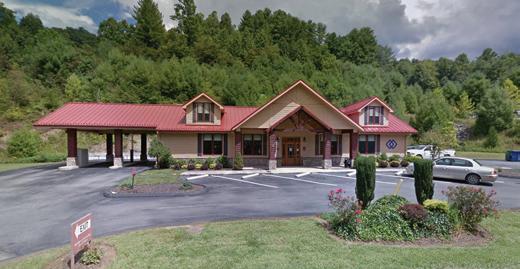Roan Mountain Magazine
May 2025



















May 2025



















May 2025
STAFF
PUBLISHER/EDITOR
Amy Thurman
amy@roanmountainmagazine.com
EDITORIAL ASSISTANT
Diana Tolley
EDITORIAL ASSISTANT
Susie Phillips
STAFF WRITER
Ericka Hughes
GUN TALK WITH JON
Captain Jon Strydom
NEWS FROM THE ROAN CeCe Studer
PEACE OF MIND WITH CHRIS
Christopher Adams
THE LAST WORD & THE GRACE PLACE
Noah Blair
STAFF PHOTOGRAPHER
Faith Lynn
CONTRIBUTORS
Renee Russell
Copyright © 2025
All content herein is copyright protected and may not be reproduced in whole or part without express written permission.
Roan Mountain Magazine is published monthly and can be found at multiple locations throughout the Roan Mountain area, free to readers. We are not currently offering print subscriptions, but please contact us if you are unable to find a copy. (423) 440-9012
Read the Digital Version at: www.RoanMountainMagazine.com

Roan Mountain Magazine is printed by The Elizabethton
Letters to the Editor: We would love to hear from you! Questions, comments, ideas, or whatever you’d like to share, please send to Amy: amy@roanmountainmagazine.com
18 Business Spotlight
Craig and Tracy Blake's Doe River Landing is flourishing.
19 Summer Reading Program
Kids get a free lunch, a book and storytime at Magill this summer.
20 A Tribute to Moms
Messages to mom to celebrate Mother's Day in style.
24 Music Spotlight
This month Ericka shares The Ericka Renee McKinney Band.
26 Beekeeping with Bertha
We talked with local resident Bertha Johnson about the basics of bees.
Editor’s Letter
Gun Talk with Jon Taste of the Roan The Grace Place News from the Roan Peace of Mind with Chris Fun Page The Last Word (What's Going On will return next month.)
ABOUT THE COVER:
It's bee time! Learn more about beekeeping in the feature starting on page 26, with Bertha Johnson. Many thanks to Faith Lynn for this great shot of a honeybee.
Photo by Faith Lynn
30 Chief Cares
Eric Church's foundation is building homes in NC for hurricane survivors.
32 Short Story
Young Rosie forages for many of our favorite wild edibles.
35 Lessons in Life & Landscaping
Staff writer Ericka Hughes launches her first column!
37 Resilient Road
This month's uplifting story about local storm recovery efforts features Marley Turbyfill.
Publisher's Note:
We're thrilled to increase our page count this month, from 32 to 40 pages!
Thank you to our advertisers for making this happen and thank you to staff for stepping up with even more great content!









Diana’s short story this month, Vittles Fit for a King sparked happy memories of my childhood. Before we moved to town when I was 10, we lived in a small rural farming community, a cluster of homes set among farmland, alongside a creek. When not in school I was allowed to roam, as long as I was home before supper, and one of my favorite things to do was follow the creek. I’d hike or wade, either as far as I could go before I had to turn back to be home on time, or to a favorite spot along the way. A large tree grew out of the bank there, with a wide base that had a shallow indent perfect for sitting. I’d pack a lunch, which, since we were dirt poor, usually consisted of a sandwich made with homemade bread and homemade jelly (occasionally there was butter or peanut butter to go with it), and occasionally a tart cooking apple from the tree on our property, or I could sometimes swipe a cucumber or tomato from the garden on my way out. Sometimes I’d take a book to read, and sometimes, if I had one, I’d take a small sketch pad and pencil. After we moved to town, I found a small creek not far from our house, but there were too many houses along it, not enough birdsong, shade, or quiet, and it was muddy, rather than rocky. But then the Mississippi River flooded and we had to go live elsewhere for about six months until the river receded and repairs could be made. During that time, and five or six more times over the next several years when the river came up, we stayed in a house, little more than a shack really, way out in the middle of nowhere. It sat in a clearing about halfway up a huge hill, surrounded by woods. And there was a creek! It was about the size of the Doe where it runs through town here, rocky, and shaded by plenty of trees. Not a house in sight. In spite of the inconveniences there, like having to bathe in a metal tub and share a room with my little brother, not to mention the stress of getting out of our house in town as flood waters were rising and the work I knew would come after, I was always excited to get back out to the country, to my creek and those woods.
Many of my happiest childhood memories are of hiking along (or in, when it was warm enough) those creeks. I didn’t have a wise granny to share her wisdom with me, like Rosie did, in Diana’s story. But somewhere along the way I’d learned about a few edible wild plants, like wild growing blackberries, or sheepshire, or one I’ve forgotten the name of but to this day I’d recognize the taste if I ate a piece of it blindfolded, and I was thrilled to see it growing here, too. I’d supplement my meager sandwich with whatever I could forage, and drink water from the creek. Alone with my thoughts and daydreams for most of the day (which has always been my idea of heaven), looking at the different birds and listening to their songs, sitting quietly for a while to see if a squirrel,

This is the wild plant I snacked on as a child, growing right here in my yard! Does anyone know what it's called?
rabbit, or bird might approach, or if I might spot a small fish or crawdad in the creek. Watching the play of light through the trees. Finding pretty rocks. Taking off my worn-out tennis shoes and wading when I got too hot, or, on the really hot days, finding a deep spot and getting soaked from head to toe, hoping I’d be dry by the time I got home so I wouldn’t get in trouble. Pure heaven. Pure peace.
Last summer I was unable to explore local creeks and rivers due to a broken ankle, but this summer, I’m going to make that happen. I’ll probably take a slightly more substantial sandwich and a thermos of water, and I’ll wear my trusty hiking boots, but I don’t have to be home by dinner and if I want to soak myself to cool off, I don’t have to worry about getting dry in time!
Just the thought is enough to stir my soul. Thank you, Diana, for the reminder. It’s easy to get caught up in the day to day, but we have to make time for those things that fill us with peace. I hope you’ll all find time this summer to wade in your own creeks, or whatever your version of peace is.
See you 'round the Roan!
Amy Campbell Clark Editor amy@roanmountainmagazine.com






In a world full of fleeting things, there’s something to be said for the stories we carry — and the objects that carry them for us. In Roan Mountain, where the mountains hold their quiet memories, one little pistol added another chapter to its 50-year saga, surviving both the test of time and the storm's wrath.
Let me tell you about my friend — we’ll call him George. George picked up a little Ruger Standard .22 pistol nearly half a century ago. For decades, that pistol was his faithful companion. It always hit its mark, whether he was chasing quail through thickets, knocking off rats skulking around the chicken coop, or keeping the groundhog population in check. Lightweight, accurate, and smooth to shoot — it wasn’t just a tool, it was a favorite. A part of his life.
Then came Hurricane Helene.
Last year, Helene barreled through the South with rising waters that left destruction in its wake. George’s cabin on Jack’s River in Georgia didn’t stand a chance. As the waters crept higher, George and his family raced to save what they could — birth certificates, family photos, heirlooms — things you can never quite replace. In the scramble, that little Ruger, tucked away in a case under the seat of his son’s Ford Explorer, was forgotten.
By the time the waters receded, the Explorer had been carried nearly three-quarters of a mile downstream. A battered, broken hulk of a vehicle, filled with sand, glass, river rock, and soaked memories. The SUV lay hidden under debris for almost two months as the family focused on gutting the flood-damaged house and trying to put their lives back together.
Eventually, they hauled the wreck from the riverbed and began to sift through what could be salvaged. And that’s when George found the little Ruger, rusted, pitted, and jammed solid with Georgia river silt. It looked like the end of the road for his favorite .22.
But George is stubborn. He took it apart, cleaned

By Captain Jon Strydom (aka African Jon)
it, scrubbed it with sandpaper and emery cloth until his hands were raw. The rust fought back. The pitting wouldn’t budge. That’s when the pistol came to me.
In my shop, I gave that pistol what could only be called a baptism by fire and water. Many hours were spent grinding and sanding away the years — and the flood. Fine-grit sandblasting came next, and then a plunge into a boiling tank of caustic salts and lye at 300 degrees. After 30 minutes of intense heat, it was quenched in cold distilled water, then simmered in another bath of boiling distilled water to flush out every last trace of salt and corrosion. Each piece was inspected, oiled, and carefully reassembled. Finally, ten rounds downrange confirmed the gun still had its soul — it fired flawlessly.
George has his Ruger back now. It’s not just clean and functional — it looks sharp, sleek, like it could be fresh off the shelf. But more importantly, it carries a story now. A story of floods, loss, grit, and revival. A testament to how some things, like the Roan Mountain ridgelines and the bonds we form with the tools of our trade, are worth restoring.
That little pistol may have been forgotten in the chaos, but it’s not going anywhere now. It’s back where it belongs — at George’s side, ready for the next chapter in a well-lived life.
As always - stay safe out there.

Submitted
by
Pamela Bernardo
4-6 boneless, skin-on chicken thighs
6 sprigs thyme
1 cup morel mushrooms, chopped
12 ramps
1 cup chicken stock
¼ cup cider vinegar
2 tsp kosher salt
1 tsp honey
½ tsp ground black pepper
• Season thighs with salt and pepper.
• Scatter thyme sprigs around the chicken then refrigerate, uncovered, for at least one hour (up to 6). This will dry the skin to help it crisp and allow chicken to absorb the scent of thyme.
• Preheat your oven to 375°F.
• Place chicken skin-side down in a cast iron skillet and brown over medium heat. Then turn skin-side up and transfer skillet to oven. Bake for 30 minutes.
• While chicken is baking, clean mushrooms with a dry cloth.
• Separate the ramp greens from the stems; finely chop stems and coarsely chop greens.
• After 30 minutes in oven, remove chicken from skillet and set aside.
• Discard all but about 1 tbsp of rendered fat from the pan, then add ramp stems and cook one minute.
• Add chicken stock, vinegar, honey, and ramp tops, cook until stock is reduced by half and the ramp tops are dark and soft.
• Return chicken to skillet, arrange the morels around the chicken and spoon sauce over both chicken and the mushrooms.
• Return skillet to oven to cook until mushrooms are done, about 15 minutes.
Have a recipe to share? We might be able to include it in an upcoming issue. Ideally with seasonally available ingredients, and if you have a photo of the prepared dish, send that along too! amy@roanmountainmagazine.com
We had two great recipe submissions this month and couldn't decide which to use, to here are both! Thank you ladies! Enjoy!
INGREDIENTS
2 boneless skiness chicken breasts
1 cup chopped morel mushrooms
1 finely diced shallot (or use ramps!)
¼ cup madeira wine
¼ cup of chicken stock
¼ cup of cream
Salt and pepper to taste
Olive oil
DIRECTIONS
• Heat olive oil over medium heat in a large saute pan. Add morel mushrooms, season with salt and pepper then stir to coat mushrooms with oil. Cook until lightly brown and until all water has evaporated. Remove from pan and set aside.
• While the morels cook, rinse the chicken and pat dry, then gently pound out to even thickness. Season with salt and pepper, add a bit more olive oil if need and place chicken in skillet.
• Sear each side over medium high heat, then reduce heat and cook just until done. Place in a shallow baking dish and place in 200° oven to keep warm.
• Add shallots (or ramps) to skillet and cook for about a minute.
• Add wine to deglaze the pan, and simmer until reduced by half.
• Add chicken stock, and again reduce by half.
• Add cream, and simmer until sauce reaches a nice consistency.
• Return mushrooms to pan, and heat for a minute.
• Plate your chicken and ladle mushroom sauce over top.















By Noah Blair
The book of Isaiah is well known and often quoted in the church today. It has a rich history and plays an integral part of the Bible. I’ve heard a verse from Isaiah quoted more often than any other since coming on board as pastor for Roan Mountain Free Holiness church here in town. Don Julian has pastored here for nearly 50 years, and he cites Isaiah 54:17 frequently.
“No weapon that is formed against thee shall prosper, and every tongue that shall rise against thee in judgment thou shalt condemn. This is the heritage of the servants of the Lord, and their righteousness is of me, saith the Lord.”
Don loves to quote this verse and make a point that I believe should be a point we as Christians should remind ourselves of frequently. The verse does not say, “no weapon will be formed against me,” rather, as Don points out, the scripture does not promise us there will not be weapons formed against, however, it does promise that when those weapons are formed they will not prosper against us.
This truth becomes evident when the storms and struggles of life begin to rock the boats of our lives. If we were to misread this scripture when the storms come and waves began to rock our boats, we would be left hopeless and overwhelmed by the circumstances we found ourselves in. However when we consider what scripture promises us, then we can find rest and comfort in the promise of knowing that we are protected by the Almighty’s love for us and that he will not let any weapon formed against us to prosper.
As Christians in the world today we can easily let the current struggles overwhelm us and distract us from the truths of God’s Word. I thank the Lord for his promises that cover us and protect us from the weapons that are formed against us. I hope that you will put this truth into practice in your own life to help better fight the worries and concerns of this world that is not our home. Walk in faith and know that your Savior loves you and will protect you.

“No weapon that is formed against thee shall prosper ...”
Isaiah 54:17






Here at Roan Mountain State Park, we eagerly look forward to guests arriving for the warmer weather as we have officially marked the beginning of the camping season!
We are pleased to announce that the camp store is open for the season from now until October 31, 2025. Our campers can expect a variety of amenities at the camp store, from camping essentials, souvenirs, to ice, firewood, snacks, candy, and drinks. We even offer a selection from local vendors, like honey, soaps, lotions and coffee. Be sure to stop on by the camp store (and our visitor center) and help support a local vendor from our community, grab that little necessity you may have forgotten to pack, or add to that souvenir collection you may have.
Camping ... It’s more than just a vacation, or a little getaway. It’s a way to create lasting memories. Memories with friends and family. Memories of gazing at the stars at night, hiking a quiet trail, playing in the creek as children, or making smores around the campfire. It’s a time to reconnect with nature, experience new activities and spend time with loved ones.
While camping here, you can expect wellmaintained campsites and restroom facilities. Our staff works hard so you can have a positive and enjoyable experience during your stay. To help facilitate this, we are honored to have Mike McCormick back as a campground host this year. He has been a critical part of our team and ensures that our visitors experience tidy and well-kept campsites. He volunteers at our park by cleaning fire pits and grills, clears campsites of leaves and debris, does after hours bathhouse checks and performs various other maintenance tasks. If you have not yet met him, be sure to say hi when you see him roaming the campground.

During your stay with us, don’t forget to take time to explore the scenic beauty and the many recreational opportunities our park has to offer. You can hike along the creeks and ridges, tour the century-old Miller Farmstead, hike one of our many trails, or just sit back and relax while enjoying the natural beauty and wonders that are all around. Listen to the trees blowing in the cool breeze, the birds chirping, or enjoy the Doe River flowing through the campground! Be sure to check for some fun and educational programs
By CeCe Studer
Roan Mountain State Park
that might be occurring during your visit. Please check our park’s website at tnstateparks.com/parks/ roan-mountain for more information and to check for trail closures, as half of our trails are still closed due to hurricane Helene damage.
In addition, because of hurricane Helene, the upper campground will remain closed this summer due to significant damage to the bridge leading to the campsites. TDOT (Tennessee Department of Transportation) is currently developing a plan to rebuild the bridge. We deeply regret the inconvenience and disappointment this may cause our visitors and are working as quickly as possible to reopen the upper campground for everyone to enjoy. Check our park's website or Facebook page for updates on when the upper campground is accessible.
To make a reservation, please visit the Tennessee State Park website or call the park’s reservation number. Book your stay soon as our campground tends to fill up quickly, especially during the peak season and weekends. If you do not have a recreational vehicle to camp in, keep in mind we do have 30 cabins as well! We hope to see you soon!

a


•
•
•



















As a therapist educated in psychological theory and experienced with numerous clinical cases and diverse approaches, I believe the Bible is the most powerful tool for enhancing mental health. The Word of God surpasses clinical journals and self-help books. I've observed profound transformations in mental health among individuals who apply biblical principles in their therapy and daily lives.
This supports the wisdom that Jesus is indeed the Way, the Truth, and the Life. Engaging with the truth positively impacts mental health. Therefore, counseling or therapy incorporating biblical principles is arguably the most effective healing and mental wellness approach.
A skilled therapist creates a safe and supportive environment that encourages clients to explore their inner selves honestly. This self-exploration, which improves mood, behavior, and overall wellness through behavioral health strategies, is grounded in the Word of God.
While seeking Truth is a fundamental aspect of both the Bible and effective therapy, we must be mindful of potential challenges. Our emotions, though inherently God-given signals prompting vital reflection, can complicate our quest for truth. Feelings are not the ultimate truth. Negative emotions, such as fear, anger, anxiety, sadness, and guilt, can often mislead us; acting on these feelings may lead to negative consequences. Such actions can result in regret and damage our relationships.
Although the Bible acknowledges the importance of emotions, it emphasizes the need to be guided by God’s word and spirit rather than allowing feelings to dominate our decisions. When we permit our emotions to govern our choices, it can lead to sin and poor mental health. Instead, we should concentrate on positive emotions such as compassion, kindness, and love, which nurture healthy relationships and personal growth.
The Bible and compassionate, effective therapists strive to support individuals grappling with life's challenges. Each aims to approach vulnerable individuals with empathy and intention, providing a pathway to hope. Central to our relationship with God and the therapeutic bond is the understanding that every person possesses a unique history, strengths, weaknesses, and divine purpose. While God all uniquely creates us in His image, our focus should not be on ourselves.
We can enhance our lives by loving and caring for others rather than focusing on ourselves. The Bible rightly cautions us against being self-centered, selfish, or prideful. We are meant to love others and actively contribute to their well-being. This is also a brilliant lesson for mental health, as misery often stems from excessive internal focus. Effective therapy, like the
By Christopher Adams LCSW Licensed Therapist
Bible, recommends steering clear of this behavior.
Whether reading the Bible or engaging in mental health therapy, a desire for positive transformation is essential. The scripture wisely reminds us, “wisdom begins with the fear of the Lord…” emphasizing the vital humility needed to attain wisdom. This applies to both our relationship with God and our counseling journey. We must recognize our imperfections and strive to improve. Each of us has a responsibility for our lives and decisions. Personal accountability is a central theme in both biblical teachings and effective therapy. We are evaluated by “our fruit," which reflects our actions and behaviors. We are called to align our choices with God's standards. The Bible underscores this principle, which in turn promotes good mental health.
When we confront our shortcomings sincerely, redemption is possible as we seek forgiveness and embrace a transformed heart. This process involves improving ourselves by acquiring wisdom and genuinely wishing to change our actions. The concept of redemption is vital in both the Bible and counseling. It necessitates a thoughtful self-reflection accompanied by a genuine intention to grow. Therapy can provide a secure environment for this journey while the Lord grants true forgiveness.
Counseling is certainly not a replacement for a relationship with God. However, it can enhance our journey with the Lord when it is appropriate and consistent with biblical teachings. As a therapist, I understand my flaws and recognize my need for God’s guidance. This limited wisdom may resonate with others who are in search of truth. Therefore, I pray daily that God uses me to assist individuals seeking wellness. I ask that He bring those who fit into His plan for their journeys. It would be my honor to support you on your path to Truth. Please don't hesitate to reach out if you need assistance. Sincerely, Chris
Sincerely,
Chris
By Ericka Hughes
Tucked beside the Doe River and surrounded by the quiet strength of Roan Mountain, Doe River Landing is more than a place to stay—it's a place to pause, breathe, and feel grounded. With long trails, trout-filled waters, and the kind of stillness that settles the mind, it offers visitors a chance to reconnect with nature, with family, and sometimes with themselves.
In 2024, Craig and Tracy Blake took a leap of faith and became the new owners of the property. Since then, they've poured heart, sweat, and intention into every corner – refining the cabins, adding trails, expanding outdoor spaces, and shaping the land into a family-friendly retreat built with care and love.
From the moment I arrived, they welcomed me with warmth and hospitality. We walked trails, stepped into a few of the cabins, and chatted about everything from fish to floodwaters. The cabins were spotless and thoughtfully designed, each with its own personality and rustic charm. As Craig put it with a smile, “It's a hotel in the woods."
Where the River Runs
The Doe River isn't just a backdrop, it's part of the story. Guests are welcome to fish the cool waters for brook, brown, and rainbow trout. Each of the cabins are named after one of these native fish, and their interiors reflect the theme in subtle, creative ways. It's a personal touch that speaks to the Blake’s deep connection with the land.
The property is designed with families in mind. There's a playground for kids, peaceful fire pit seating areas, and scenic trails that wind along the river's edge. Whether it's for rest, celebration, or simple escape, Doe River Landing invites visitors to slow down and stay awhile.
Inside the cabins, guests will find Wi-Fi and smart TVs, but step outside, and it’s all river sounds, rustling trees, and mountain air. It’s a place where modern convenience and raw nature manage to coexist.
At the center of the property is the Water's Edge Pavilion—a stone-and-wood event space with a fireplace, kitchen, heating, and air conditioning. It's become a favorite venue for weddings, family reunions, and baby showers.
More than once, guests have rented the entire property for wedding weekends, which includes the cabins, RV sites, and pavilion. One cabin often becomes a suite for the bride, while the rest of the family spreads out across the grounds. "It's theirs

for the weekend," Craig said. "We've had the whole shebang rented out."
The pavilion can be booked for half-day or full-day events, and the Blake’s recommend reserving well in advance, especially during the busy fall season. "August is a little slower," Craig noted, "but once the leaves start changing, we're full."
Only six months after opening, Hurricane Helene swept through Roan Mountain. Floodwaters forced cancellations and crept across the infield, leaving Craig and Tracy wondering if they were about to lose everything they had just begun.
"I thought I lost it all," Craig said. "We were here during the storm. I was trying to hitch up the trailer as the water kept rising. I was practically in tears."
Though the water came dangerously close, the cabins were spared—an outcome the Blake’s still speak of with gratitude. “God's hand protected it. There's a reason for that, we see ourselves as the caretakers now. It gave us faith that we're meant to be here,” said Craig and Tracy.
The Blake’s aren't finished. Their vision for Doe River Landing continues to grow, always with respect for the land and those who visit it.
They hope to add more cabins and construct decks along the river. There are also plans to create pullthrough RV sites and install sewer hookups for added convenience, as well as fun events planned—all while preserving the natural peace of the place.
Doe River Landing is a reflection of the people behind it—steadfast, welcoming, and deeply tied to the land. It's a space to fish, to gather, to celebrate, and to rediscover a quieter way of being.
When asked what they most want people to know about the place, Craig and Tracy didn't pause:
"It's a little slice of heaven."
By Susie Phillips
Magill Memorial Church is so happy to be hosting our Summer Reading and Lunch program for the second year!
Children of all ages, toddler to teens, are welcome to join us for a hot, kid friendly lunch and storytime. While there, children are welcome to browse in our library for a free book to take home. Also going home weekly, each family will receive a bag of nonperishable food items.

We have partnered with TLC Community Center in Elizabethton to provide the food packages. Since 2002 TLC has had a mission to let no child go hungry during the summer months when school is out.
The books in our library come from multiple sources. Last year Ronald McDonald house in Johnson City donated 50 children’s books. Many of the books for middle to high school readers come from The Book Exchange in Banner Elk and others were donated by church members. If you have new or gently used books you'd like to donate, we will happily take them off your hands.
We are also pleased to announce that there will be a Roan Mountain State Park Ranger dropping by with earth friendly activities and learning materials.
Parents and caregivers are encouraged to stay and share the meal with their children.
The program will run for 9 weeks every Monday at 11:30 am starting June 2nd through July 28th. Please mark your calendars.

Magill is located at 296 Hwy 143 in Roan Mountain.
To donate books please contact Susie Phillips at susiemp62@gmail.com.

To Kandace Baker, From Jordan & Victoria Baker



“Thank you for your endless love, strength and support. You are the heart of our family and we are so grateful for you every single day. Love you always and Happy Mother’s Day!”
To Eleanor McKinney, From Kathy Powell

“She was a GREAT mother. There were thirteen of us young’uns and thirteen isn’t an unlucky number at all; we all survived! I want to wish her a Happy Mother’s Day in Heaven!”
To Elaine Johnson, From Sam Lyons


“You’re my rock, Mom, the best woman I’ve ever known. Happy Mother’s Day. Love you.”
To Regina Buck, From Jace Buck
“Mom, you’ve always stood by me. You’ve always been there when I’ve needed you. Thank you, Mama for all the love and prayers. I love you and have a happy Mother’s Day.”
To Shannon Day, From Courtney & Mia To Rita Watts, From Tiffany Laws


“Happy Mother’s Day to the strongest, most tender hearted, hardworking, loving and best mother any child could have. We thank God for choosing you to be our mother. We pray every day that we can be the woman and mother that you are. We love you so much!”

“I would like to thank my mom for always being there for me, through the good and the bad. I thank God every day for choosing her to be my mom. Happy Mother’s day, Mom!”

To Diana Tolley, From Robert Tolley To Sandy Blair, From Brian Blair

“A mother’s love is like a star. Bright, warm and everlasting, shining bright in the far above. Forever and always, my mother you’ll be.”


“I know you’ve been through a lot, Mom. You’re the toughest woman I know. If I could pick any woman in the world to be my mother, I’d still pick you. Happy Mother’s Day. I love you.”




To Bertha Johnson, From Melvin Johnson


“My mom is such a good person and the kindest person I know. And she put up with me! I love you, Mom! Happy Mother’s Day!”



To Gail English, From Kimberly English Holtsclaw
“There aren’t words to thank you for who you are and who you’ve taught me to be. I love you! Happy Mother’s Day!”
To Amanda Christman, From Izabella Christman To Nola Mae Cook, From Darla McKinney
“Happy Mother’s Day. I wouldn’t be the person I am without a strong, beautiful woman like you to look up to. You’ve always been my #1 supporter in everything I do. You didn’t know it, I’ve always been your #1 supporter, too! I love you!”
To Diana Stockton, From Bekah Thompson
"My mom has always been a constant in my life, my unwavering support. She's the epitome of compassion and I'm endlessly grateful for her love. Having her by my side is one of my life's greatest blessings. I love you, Mom, my ol' fencepost!
To Amy Thurman, From Jay Rich

“I love you, Mama, and miss you every single day. Happy Mother’s Day.”
To Joyce Greaser, From Robin Smith

“She was a wonderful mother. There were 8 of us children and she always took the very best care of us. Happy Mother’s Day in Heaven, Mom.”


“My mama is a great lady who make the best gravy I’ve ever tasted. Happy Mother’s Day, Mom. I’m so glad I’m the favorite son! I love you!”








By Ericka Hughes
In Newland, North Carolina, cradled by the Appalachian Mountains, a new voice is echoing across the hills, one built with purpose, grit and heart. It belongs to The Erica Renee McKinney Band. A band whose music springs from the soil of the mountains, steeped in kinfolk bonds and the rhythms of rural life.
Formed in August 2023, the band blends country rock with the soulful depth of Appalachian gospel. At the center is Erica Renee McKinney, a native of Avery County, whose voice carries both the softness of mountain mornings and the strength of the people who shaped her. Erica leads the band with powerful vocals and heartfelt piano, anchoring every song with a sound that feels both timeless and true.
"We’ve got a country rock sound," Erica says, "but there’s a lot of soul and gospel in it too. It just comes out naturally."
Supporting Erica on stage is a tightly-knit group who share a strong bond both musically and personally.
Her husband, Scotty McKinney, keeps the rhythm steady and powerful on drums. Seth Beers provides the bass foundations. Guitarists Shawn Turbyfill and Mike Stamey deliver energetic and melodic guitar work, and Lee Turbyfill adds rich acoustic guitar textures and complementary vocals. Together, their music reflects the traditions and experiences of their Appalachian roots.
Singing the Stories of the Mountains
Songwriting comes naturally to Erica. “Songs often come to me in dreams,” she explains. “I’ll wake up and head straight to the piano to capture them before they're gone.”
Her songs are heartfelt and accessible, drawing listeners into relatable experiences. She combines natural intuition with professional training in songwriting and vocal performance to deliver music

with both depth and emotional connection.
The band’s influences stretch wide. From Goose Creek Symphony to Guns N’ Roses to Bill Monroe, but their sound is their own. Their upcoming project, Mountain Thing, is a full album in the works: a celebration of Appalachian spirit, language, tradition, and wisdom.
Building a band takes more than practice. It takes patience, trust, and a willingness to put people before ego.
"The biggest obstacle has been learning what each person needs, and figuring out how to put each other first," Erica says.
In the early days, they practiced twice a week while holding full-time jobs. Over time, the dream shifted. The goal now is to leave the grind behind and focus full-time on the music.
Over the last year, the band has played at venues throughout the region, including The Village, in Banner Elk and the Linville Ridge Country Club, where Erica opened a special event with a striking rendition of the Star-Spangled Banner.
They’ve also performed at the Singing on
Grandfather music festival, one of the region’s most beloved celebrations of mountain music. But ask them where they feel most at home, and they’ll say the porch.
"There's just something about it," Erica says. "The vibe is more relaxed. It's happy."
When they’re not on stage, they bring music to front steps, visiting folks across the community and playing just to bring a little joy.
"We want people to have a good time," Erica says. "That’s what it’s about—bringing music right to where people live."
The Road Forward
Looking ahead, The Erica Renee McKinney Band plans to record more original songs and play wherever folks want to listen—be it on stages, festivals, or someone’s front porch. They’re not chasing anything flashy. They’re just staying true to themselves, living the life they sing about.
"People should always be themselves and give space to others to be themselves—and just enjoy life," Erica says.
If you’d like to follow their journey or reach out about booking a performance, you can find them on Facebook, Instagram, or through their website at ericareneemckinney. com. You can also listen on YouTube at bit.ly/ ericareneemckinney.
Whether it’s a stage or a front porch swing, they’re always glad to share a song with good folks.




Bertha Johnson and I sat on her front porch one Saturday morning as she answered my questions and shared her knowledge, and enthusiasm, for beekeeping. Although she suffered a stroke in 2020, she’s worked hard to get back to the point where she could do what she loves: keeping bees. She’s an inspiration.
By Amy Campbell Clark


Bertha loves being outside, whether she’s splitting wood, working in her yard, or just passing time on her front porch, but one of her favorite things to do outside is beekeeping. She grew up watching her dad, Jacob “Bill” Johnson, tending his bee hives, and always dreamed of keeping bees herself. About 12 years ago, she was finally able to make that dream a reality. She started with one box and set it up with the help of a friend, then purchased a swarm from a local man.
“That one box hooked me,” she said, with a wide grin.
Before long, she was collecting swarms herself and added several more hives. Bees swarm when the hive becomes too crowded. The bees will create a queen cell to hatch a new queen; she will then leave the hive taking bees with her and they’ll swarm in a large cluster while scout bees seek out a new hive. To collect a swarm, you must get the queen into a box and the others will follow. This can be a tricky process, but purchasing bees can be expensive, and, as Bertha said, “Wild is better.”
The hive consists of a brood box and, if you want to harvest honey for consumption, one or more supers.


Like raising any sort of animal, some care is required. Bees must be treated for parasites in the fall with medicinal strips that are left in the hive for about two weeks. Bees must also have a water supply nearby, but never place water inside the hive. While some beekeepers do “feed” their bees over winter with sugared water, Bertha doesn’t do this. The water can freeze inside the hive and cause problems. It’s better to leave enough honey for the bees to overwinter naturally. Also, honey from bees fed with sugar will crystalize. Native flowering plants are the best sources of food for honeybees and Bertha tries to leave the area around the hives as natural as possible.

The brood box contains rows of sashes, which are wood frames strung with thin wires that hold a sheet of wax. When bees take up residence in the brood box, they begin constructing waxy honeycomb, where the queen lays her eggs and honey is deposited. Eggs fertilized by male “drone” bees will hatch into female “nurse” bees, whose job is to care for the queen, while unfertilized eggs will hatch into more drones.
Honey in the brood box shouldn’t be harvested as it’s needed to keep the bees alive. To produce honey for consumption, a device called an extruder, which looks a lot like a small grate for a barbeque grill, is placed on top of the brood box to contain the queen, and a super is placed on top of that.
A strong hive can produce two supers of honey in a season. Honey should be harvested before goldenrod starts to bloom. “It’s a good source of food for bees to keep them strong over the winter, but the honey tends to be bitter, and you don’t want your bees to starve,” Bertha explained.

Every bee in the hive has a job. The queen’s job is to lay eggs to ensure the continuation of the hive. Female nurse bees tend to her, drone bees fertilize the eggs, there are guard bees that protect the hive from potential predators, worker bees that gather pollen and nectar, and the scout bees mentioned early, who find a suitable hive during the swarm.
The super is a slightly shorter version of the main hive box with an open bottom, that also contains sashes where bees will construct honeycomb and produce honey, but with the queen contained below, no eggs are laid in the super.



After answering my questions, Bertha led me out to two hives in her yard. I got close enough to take some pictures, but was careful to be as still as possible and move slowly to avoid agitating the dozens of bees that were flying around near us. Bertha had offered me a protective jacket with a mesh hood, but it was a little too warm out. I had a bottle of liquid Benadryl with me, just in case I got stung and had any sort of reaction, but luckily I didn’t get stung.
Although she does occasionally use a smoker to keep the bees calm when she’s working with the hives, she prefers to use sugar water in a spray bottle. “It’s a light mist that won’t weigh down their wings, but it keeps them occupied. They’re paying attention to the sugar, not to me,” she said. And sure enough, she spritzed it around the hive and the bees settled, allowing her to take the top off one of the hives to show me the sashes. The beginnings of honeycomb were visible and bees were actively working. It was fascinating, especially when you consider that these little winged creatures are so critical to our very existence.
It started to rain as she recovered the hive, so we wrapped up for the day. However, there’s more to this story, to include harvesting the honey, so I’ll visit with Bertha again at harvest time and share what I learn. She also graciously agreed to help me set up a hive of my own next spring!
Many thanks to Bertha for taking the time to share her joy and knowledge with me.




Look for another article later this summer when Bertha harvests honey from her hives.

Opposite page: Bertha in her protetive bee jacket, removes the cover of a hive to show me bee activity and to scrape off honeycomb the bees have begun constructing on the inner cover. She removes this to ensure the cover closes securely.
This page, left: This is a fairly new sash, but even this early in the season, the bees have already begun building honeycomb.

By Ericka Hughes
When Hurricane Helene swept through western North Carolina in the fall of 2024, it left entire communities deeply scarred—homes were lost, histories uprooted, and lives forever changed. But in the months since, out of destruction has come something rare and hopeful, driven by determination, generosity, and the shared vision of Eric and Katherine Church.
Chief Cares, the nonprofit foundation started by Eric and Katherine in 2013, was named in honor of Eric’s grandfather, a former police chief in Granite Falls, North Carolina. Originally, their charitable efforts stretched from supporting orphanages overseas to funding animal shelters in the United States. However, when the devastation of Hurricane Helene struck close to home, the Churches shifted to a decisively local focus.
Eric didn’t simply respond with words—he wrote and released “The Darkest Hour,” dedicating all royalties directly to relief efforts. But he also knew
Photos provided by Chiefcares.org
immediate aid wasn’t enough. In November 2024, Eric made a call to his longtime friend, John Blackburn, and presented him with an ambitious plan: to build homes, create stability, and offer families a future.
By December, Blackburn officially joined as CEO, committed to transforming this vision into reality.
“Our first and biggest challenge was finding land,” Blackburn said. “You don’t simply find 30 buildable acres lying around. It had to be carefully chosen to be accessible, sustainable, and safe.”
After extensive searching, they secured a property in Newland, Avery County. Thus, the Blue Haven project was born. Construction plans quickly followed, with Clayton Homes managing the home-building process and Edgar’s Construction overseeing critical infrastructure needs, including roads, water, and sewer systems.
On April 11, 2025, the Blue Haven project officially broke ground in a humble yet powerful ceremony. Governor Josh Stein attended, along with
Representative Dudley Greene and Eric Church himself. It was filled with gratitude, community solidarity, and the turning of earth that symbolized the beginning of healing.
Ultimately, the Newland property will hold 40 to 45 homes, featuring one-, two-, and three-bedroom models. Chief Cares is committed not only to providing immediate housing solutions but creating pathways toward long-term stability and homeownership. Families will have access to affordable rent, enhanced down payment assistance, and financial counseling over a three-year period, enabling a lasting recovery and independence.
Blackburn emphasizes the human-centered nature of Blue Haven. “Helping people is the easiest part because it’s the right thing to do. It’s why we’re here,” he said.
The first round of applications went out in January, with another scheduled for early May. Each applicant is reviewed through a comprehensive case management system, coordinated by the Avery Long-Term Recovery Group. Through this group, John Blackburn works closely with Ruth Shirley and James Ury to maintain a detailed list of every known survivor impacted by Hurricane Helene. This system allows them to track individual needs, ensure that no one is overlooked, and direct support where it's needed most. Together, they raise funds, coordinate efforts, and provide personalized care at every step of the recovery process. Still, Blackburn knows recovery is rarely simple. In places where entire homes have been lost, the pull of generational land runs deep. Many families choose to stay rooted, even when the buildings are gone. “We offer resources for those folks, too.” Blackburn says. He’s also working closely with others to scout additional properties in Mitchell and Yancey counties. Moreover, Blackburn acknowledges that rebuilding is not only physical. “Seven months after the storm, the greatest need is still mental health support,” he noted. “People need someone who listens, someone to help them navigate their grief, and someone who reminds them they haven’t been forgotten.”
Eric and Katherine Church continue to play an integral role in the project. Despite their personal responsibilities, raising two children and managing Eric’s music career— they remain deeply involved. “They’re incredible,” Blackburn said. “They follow up, ask questions, and genuinely care about every detail and every
individual we’re helping.”
“They are amazing leaders of a great team that they put together to accomplish the goals they set,” he added, reflecting on Eric and Katherine Church’s vision and dedication.
At Katherine’s request, Chief Cares established an office within Newland Town Hall, ensuring that their presence remains local, consistent, and responsive. Blackburn and two additional staff members operate from this office daily, committed to transparency, accessibility, and compassion in every interaction.
Reflecting on the work, Blackburn maintains clear priorities. “We set deadlines not just to maintain progress, but because survivors need visible signs that something real and positive is happening. It’s about rebuilding trust as much as homes.”
When asked what he hopes people remember about Chief Cares and the Blue Haven project, John Blackburn didn’t hesitate.
“I want people to remember that while they suffered one of the greatest tragedies of their life, there was somebody there to give them a hand up and help them.”
Support the mission by donating at chiefcares.org. Donors will be recognized for their contributions. Additionally, Ruth Shirley of Volunteer Avery continues to accept donations and coordinate local volunteer efforts, directly supporting survivors throughout Avery County and beyond.



This column is about the kind of lessons you don’t learn from a book—lessons earned through calloused hands, repetition, and showing up every day. I’ve had to earn confidence the hard way—and I’ve found lessons in everything from weed eaters to tree rigging. Each month, I’ll share a real moment from the field, whether it’s about gear, grit, or something that caught me off guard. This time, I’m starting with a tool I used to avoid—and how mastering it became a turning point in my confidence on the

When I started landscaping, I didn’t know the first thing about operating the equipment. My hands were clumsy, and my confidence was nonexistent. I’ll never forget those early days, awkwardly wrestling with a weed eater that seemed to have a mind of its own. The sound alone was intimidating, and I’d tense up the second anyone glanced my way.
Finding Confidence Behind A Stihl
I was terrible. I’d leave patches of grass untouched and accidentally cut too close in other spots. The worst part? I didn’t want anyone to see me fail. I’d time my weed-eating sessions to when no one was around, hoping to avoid their eyes—and their judgment.
But here’s the thing about landscaping, and life: There’s no shortcut to mastering something. It took months of practice, but I slowly got better. I learned how to hold the weed eater just right, how to angle it perfectly for those clean edges, and even how to troubleshoot it when something went wrong. I stopped worrying about people watching me and started focusing on my own progress.
Fast forward to today, and I’m proud to say I’ve become skilled enough that people now compliment my work, and ask me for tips. Last year, I even treated myself to a brand-new Stihl FS 91 R. It was a full circle moment.
Lesson From The Lawn
So, what does weed eating have to do with life?
We’re all beginners at some point, and it’s easy to let fear of failure, or judgment—hold us back. But growth only happens when we’re willing to be bad at

By Ericka Hughes
something before we’re good at it. Landscaping taught me patience and resilience, two qualities that have carried me through challenges far beyond the lawn. Every time I pick up my weed eater now, I’m reminded of where I started. It’s proof that what once felt impossible is now second nature. The trick is to keep showing up, even when you feel like you don’t belong.
So, if you’re standing on the edge of something new, feeling unsure and maybe a little scared, take a deep breath and get started. It’s OK to be bad at it. In fact, it’s necessary. Because with time and effort, you’ll not only master it—you’ll look back and wonder why you ever doubted yourself. And who knows? One day, you might treat yourself to a shiny new tool as a reward for the journey.
> Let the tip of the line do the cutting—don’t force it.
> Trim left to right (most trimmers spin clockwise).
> Sweep side to side in smooth, overlapping motions.
> Keep the head slightly above the ground to avoid scalping.
> Refresh your string often—short line cuts poorly and stresses the machine.
> Use the right string thickness for the job (0.095” or higher for heavy work).
> Rinse the head with water (but not the motor housing) after each use.
> Always wear eye and ear protection, long pants, and boots.
> Never forget to observe your surroundings, especially when weedeating near traffic.
If you were wondering, the Stihl FS 91 R is a pro-grade string trimmer with a powerful 4-MIX® engine, built for tough, all-day use. It’s known for reliability, fuel efficiency, and smooth, balanced handling.
(For kids of ALL ages!)

Color this for Mom!



Help this bee find the flowers!
Armed Forces Day
Chocolate
Colorful
Cookout
Emerald
Flower Moon
Flowers
Garden
Gemini
Hatchlings
Hero
Iris
Last Day of School
Last Frost
Lily of the Valley
May
Memorial Day
Mom
Morel Mushrooms
Mothers Day
Planting
Ramps
Rememberance
Sunday Dinner
Taurus
Teachers

FIND 10 DIFFERENCES


By Renee Russell
The title of this article could easily describe so many who reside in this blessed community of Roan Mountain, but one young woman has become known by many town folks for her love for, and commitment to, her community. Her name is Marley Turbyfill, and her story is both uplifting and encouraging.
Marley is a Roan Mountain local who not only grew up here, but also passionately contributes to her town in so many ways. I learned of this through our conversations about the many ways in which she has helped her community both before and after Hurricane Helene.
In early September last year, Marley hosted “The Autumn Market” event at Eric Anderson Community Park to raise money for the Roan Mountain Recreation Foundation, which takes care of the park. This successful event raised over $400.00, and Marley hopes to host future market fundraisers in Roan Mountain. She will post these events on her business social media pages; look for Callista Flower Co. It was clear in speaking with her that this fundraiser filled Marley with such gratitude and joy, but that joyous feeling was short-lived as only a week later, Hurricane Helene ravaged through and devastated our town. She was determined to immediately begin assisting the community. She started with the launch of “Rebuilding Roan Mountain” and a GoFundMe charity to support those impacted by the devastation. These two charity events raised over $4,000.00, and helped many residents with financial needs. Items sold at this event included shirts, stickers, hats and crewnecks.
This fundraiser was only the tip of the iceberg in Marley’s determination to help her town. She then began selling “Roan Mountain Strong” merchandise which was created by Snow in July Designs. Roan Tees & Co. and Doe Valley Printers produced these items, while an anonymous donor generously contributed funds as well. Marley successfully sold many of these items and 100% of the proceeds from this fundraiser went to supporting Roan Mountain families affected by the storm.
Marley next connected with a Johnson City fundraiser called Appalachian Holler Help, which was organized by Groovy Grovers, Borderline Art, Downspout Records, The Generalist, Sam Love Productions, and Cherokee Distributing. The substantial proceeds from this fundraiser went to a Roan Mountain business that prefers to remain

anonymous. All recipients of the different fundraisers were selected with the guidance and recommendations of community leadership including school officials. Most of the charity funds were distributed in cash form while some families received grocery gift cards.
In addition to her fundraising efforts, Marley also volunteered her time at distribution centers in the area and assisted her neighbors with cleanup and recovery efforts, but she was also concerned about others who were so generously and tirelessly helping those affected by the hurricane. She worked to ensure that recovery workers were served meals, and delivered meals to local families so those in need of food would not go hungry.
This dedicated resident was impacted by the flood as well, but postponed her own recovery efforts until she’d done what she could for others.
When asked what motivated her, Marley said, “Community has always been at the heart of my business model.”
This is clearly evident given the time, effort, dedication, and resources she put forth to help her beloved community. Her devotion to and love for Roan Mountain is clearly apparent to those who know her and/or have benefitted from her generosity and passion.
By Noah Blair
Our little town is nestled in the Blue Ridge Mountains, in a sub-range referred to as the Great Smoky Mountains. The Blue Ridge Mountain range begins in Georgia and runs up through Pennsylvania covering approximately 615 miles in the process. The Great Smoky Mountain sub-range stretches across 522,427 acres roughly divided between Tennessee and North Carolina. These mountain ranges share a unique attribute that both garner their names from.
The Cherokee call this area Shaconage, which translates to “place of the blue smoke.” They believed the mountains to be sacred and according to legend the “smoke” was due to fires the ancient thunder god started as he dwelled atop the peaks of the mountains. As European explorers came through our area and
heard of the Cherokee’s names for the mountains, they coined the phrase “smoky mountains” and it stuck. If you’ve spent time on the Roan looking out over the village of Roan Mountain, you might have noticed a hazy blue look to the surrounding area. When standing amongst the clouds at the top of the Roan it is easy to see how these mountains got their names, however there is a scientific explanation for the phenomenon.
The science behind the blue haze is quite interesting. It’s only possible when you have the correct diversity of vegetation that produces hydrocarbons, called terpenes, that release into the ozone where they mix and produce aerosols which scatter wavelengths of light in the light-blue spectrum, which then gives us our blue haze-filled scenery. Science refers to this as a photochemical process. In layman terms we have the right mixture of vegetation that gives off a chemical that reflects a bluish light. Another contributing factor that puts the smoke in the smoky mountains is the moisture levels we have due to our ecosystem. When that moisture and photochemical process mixes you get the blue haze that our beautiful home mountain ranges are named after.
This phenomen not only brings scientists to our area but lots of tourist as well. In fact, the Great Smoky Mountain National Park is the most visited National Park in our entire country. Regardless if you come to the area for scientific research, vacation or if you’re lucky enough to call this area home, I think we can all agree, its beauty is unlike anything you will find in the world. Next time you are at the dinner table and you want to show off your intelligence you now can explain the process of how our mountains got their name.
Remember, Jesus loves you!






• The magazine is distributed at multiple locations in and around Roan Mountain, as well as nearby communities – we reach both locals and visitors!
• It will always be free to readers.







• 2000 are printed and distributed each month (as a start), as well as an accompanying website and social media pages.
• Highly competitive pricing, no set-up or design fees if you provide logo and images. Discounts available for long-term agreements, veterans and first responders.
• Co-op ad design and billing available.
• Discounts available for multi-media ad packages (web and print, when available).
• We’ll promote your company on our social media pages.
• We will actively support our advertisers through focused ad placement, referrals, information sharing, spotlight articles, and more.
• Your support of Roan Mountain Magazine demonstrates your support of our community, allows us to continue to support the community, and allows us to provide the magazine and our website free to our readers.
